The History of Stairs: from fascinating architecture to access barriers
“The History of Stairs” features the fascinating story of the evolution of stairs, but also their duality: stairs can either be a passage facilitator or a major barrier; an aesthetic delight or a scary obstacle!
The History of Stairs is the history of longevity itself, of the constant replication of the same structure and function. And to tell the story of stairs is to tackle the challenge of telling a never-ending tale that’s part history, part fiction. There’s much more to a staircase than meets the eye!
Exploring the duality within a staircase is not something you think about every day, and you might be wondering: is there that much to say about staircases? Well, when you work at a stairlift company, it is inevitable that you analyse stairs and staircases in all their shapes and sizes, depending on their context and function. Before you know it, you find yourself a great contemplator of staircases, either amazed by their grandeur or unsettled by how steep they are. We want to tell you all about the fascinating world of staircases!
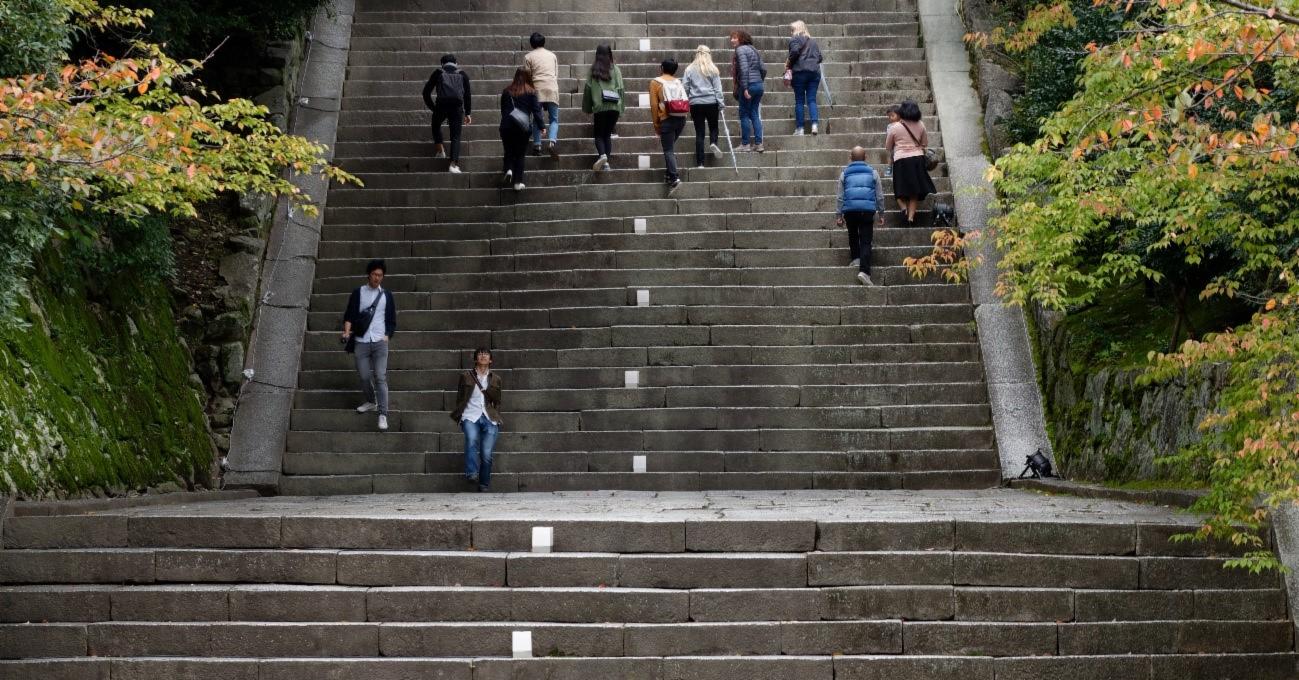
Contents
The origin of the word “stair”
Archetypal stairs: stepping on symbols
From the ladder to the double helix staircase
Staircases: a widely used metaphor in fiction
Staircases: The history of slips, trips and falls…
What’s the future for stairs in modern architecture?
Staircases in nature
Staircases can be found in virtually any building, whether it is ancient or modern. But they can also be found in perfect harmony with nature. It seems as if we have become dependent on this structure, just like we have become dependent on the wheel. Just like when the first ape discovered that it could break a nut with a stone, there must have been a first stair builder – a person who first laid stone after stone or built a ladder to climb to a higher place. Was that moment a Eureka moment for our species? Or was it such an obvious step that different individuals, from different civilizations, with no contact whatsoever, happened to discover it individually? Was it nature itself that provided them with hints through natural stair-like shapes that humans tried to imitate later?
Millions of years before humans came along and started encoding the world around them, planet earth had already created visually stunning steps of its own. These examples provide the answer to our question. All you have to do is look at a picture of the beautiful Giant’s Causeway in Northern Ireland – an area of about 40,000 interlocking basalt columns, the result of an ancient volcanic fissure eruption about 50 million years ago – to see an example of an intricate, elaborate staircase in nature.

The Giant’s Causeway, coast of County Antrim, Northern Ireland
And in fact, naturally-occurring staircases may have provided the necessary inspiration for human-made structures since the beginning of time. But what inspired us humans to start building our own? The obvious answer is geological dangers. After all, we’ve always needed to find solutions to overcome physical obstacles when we’ve wanted to gain access to higher ground.

Scala dei Turchi, Realmonte, Italy
And it’s not that big of a jump to go from naturally-occurring staircases to man-made structures in nature. Just take a look at these man-made stairs that perfectly blend in with nature to create magnificent settings for breath-taking views. For thousands of years, before stair-like structures were used inside houses, they were built into nature to provide access to remote places, especially on mountains or islands.

Stairs above the sea, Gaztelugatxe, Spain, setting for Game of Thrones “Dragonstone”
A steep, twisting staircase with 241 steps was built on the island of Gaztelugatxe, in the Basque Country in Spain, to take people all the way to the top of the island. At the very top, visitors will find a hermitage that dates all the way back to the 10th century. The hermitage can be accessed via a narrow path, which crosses the solid stone bridge. “Game of Thrones” was filmed at the location, making use of the breath-taking scenery as the backdrop for Dragonstone island. Stairs like these have been around since antiquity, and it’s amazing to think that the same simple structure is still what we build and use today. Talk about structural longevity!
But even so, what is even more astonishing is our ingenuity – our ability to reinvent, to adapt a stair-like structure to all different kinds of contexts and dimensions and spread it across all the continents.
The origin of the word “stair”
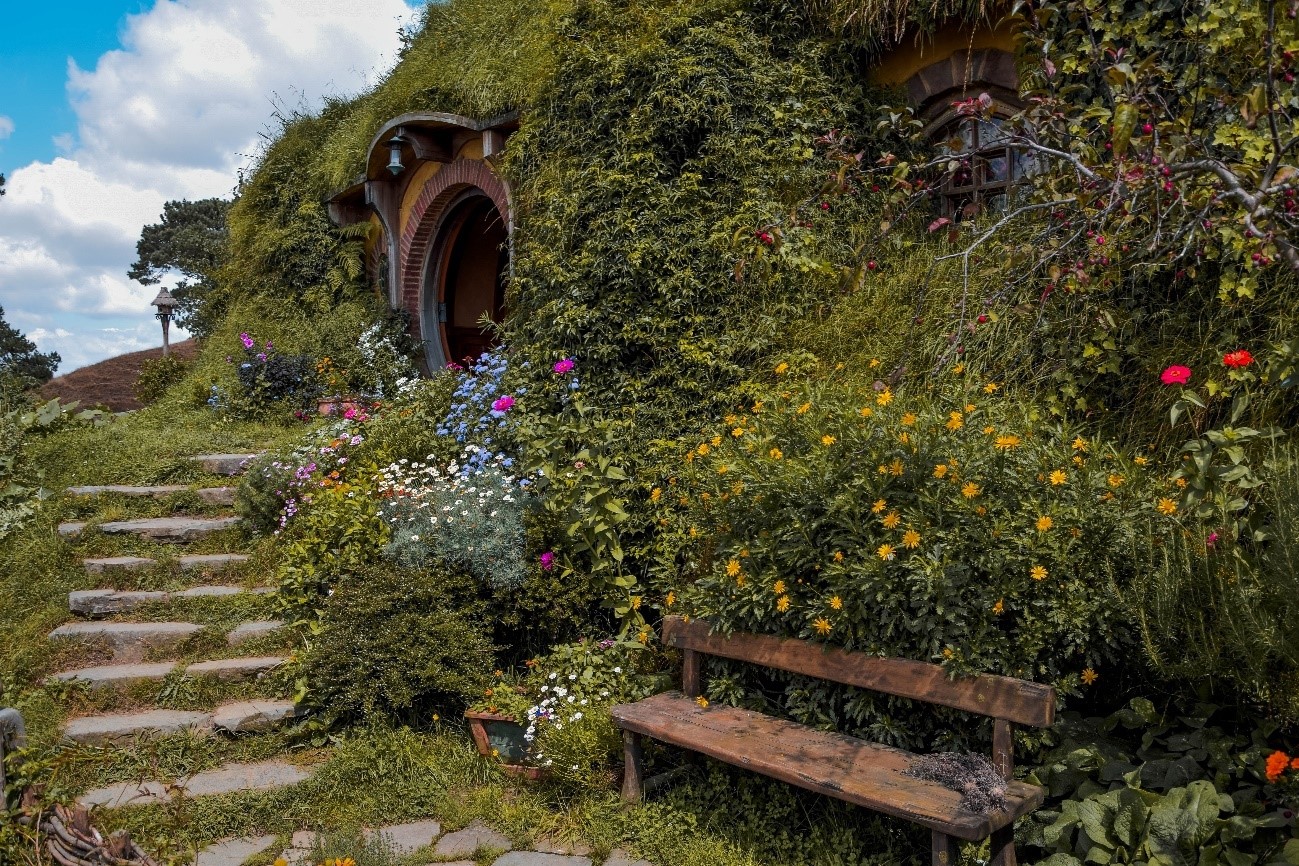
Stairs on the Hobbiton Movie set in Matamata, New Zealand (2001). Specially built for the Lord of the Rings and Hobbit movies
It is hard to work out when exactly the idea of stairs came about – when they stopped being a feature of nature and started to become a useful, intentional structure. If you truly want to know about the history of an object, you have to start with the origin of the word that designates it. Some philosophers may even say that only by giving an object a name does it begin to exist, so there must have been different moments in time, in different language roots, when the object we know as “stair” was named for the first time.
The word “stair” in old English would be “stǣger” – a word with Germanic origins which is also related to the Dutch word “steiger”, meaning “to climb”. If we think about the word “scale”, it shares the same etymological root as the Latin word for stairs: “scala”. And stairs can also perform a “scaler” function, because the dimension of steps must always conform to the comfortable limits imposed by human gait. It is curious how we end up using variants of the word “stair”, from different language roots. In romance languages the word for “stair” can be “escalera” (Spanish), “escada” (Portuguese) or “escalier” (French), all of which have a root in the Latin plural noun “scalaria”, as documented, for example, by the Roman architect Vitruvius.
From the ladder to the double helix staircase
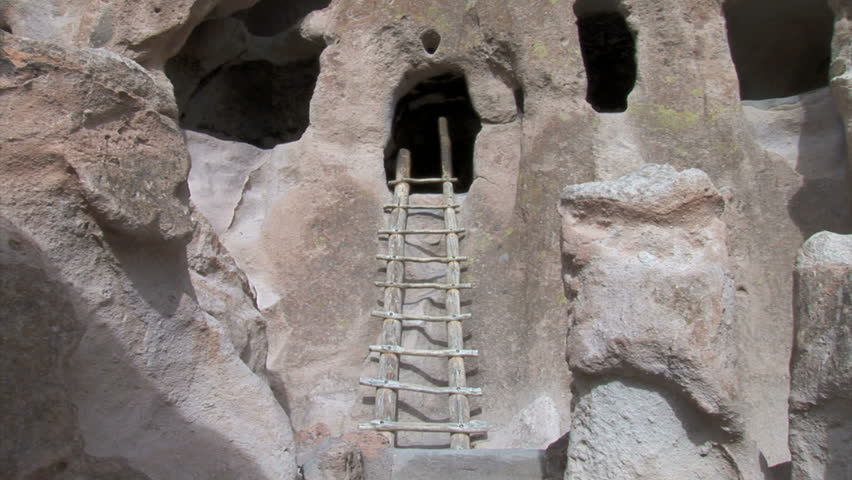
Ancient ladder, in Anasazi ruins, near Los Alamos, New Mexico
Tribes from West Africa and Panama still use one of the simplest and earliest types of stairs. Working as a separation between the ground and a house, these are used particularly in tropical countries, where people build their huts a little way off the ground so as to keep their homes safe from flooding. But it was in Mesopotamia and Egypt that the earliest straight single flight of stairs appeared, built to provide access to upper floors (Templer, p.19). Later, during the period of classical antiquity, Greco-Roman complex staircases started being built – spiral, zigzag and double-riser staircases came into being. The spiral shape was ideal to save space, and although the oldest example dates back to the 5th century BC, it was only in the wake of the influential design of the Trajan’s Column that this type of stair shape became a trend in Roman architecture. Centuries later, Medieval architects started to experiment will all kinds of dynamic shapes, but Renaissance artists were the ones to go that extra mile. Renaissance artists and architects started to build bigger staircases, to increase the potential of the staircase as an architectural structure, resulting in sumptuous baroque and mannerist staircases, all with dramatic amounts of volume (Templer, p. 60).

Château Chambord in the Loire Valley, France (1519–1547)
At the very point when it seemed that staircases couldn’t become any more complex, double helix staircases appeared. A beautiful example is the staircase in Château Chambord, in the Loire Valley, France. It is believed to have been designed by Leonardo da Vinci. A double helix staircase allowed guests, servants and royals to simultaneously move up and down the stairs without ever crossing paths.
Stairs sure did evolve quickly in terms of their aesthetic, architectural and cultural goals. In fact, they’ve even reached a point where they have become symbols that populate our imaginary world!
Archetypal stairs: stepping on symbols
An intrinsic part of being human entails both the idea of making signs and understanding them. We created a symbolic world around us and everything we build is part of a social and symbolic language. So, when it comes to the shape of stairs, they have long been archetypes – forms or images that occur all over the earth!
For thousands of years, stairs have been physical representations of power, achievement and enlightenment. From ancient times up to modernity, a staircase could often hold a significant meaning:
- Symbolically, staircases can suggest a journey;
- A staircase could be a passageway that unites any two things: places, ideas, or states of being;
- If one ascends the stairs that journey is probably positive
- However, if one descends the stairs that journey might be negative, confusing, or depressing.
“The Staircase: The Architecture of Ascent”, by Oscar Tusquets Blanca & Martine Diot, 2013, explores the history and meaning of the staircase, from a simple, straight flight of steps to a radical spiral staircase. It is interesting how we transitioned from straightforward staircases that suggested an uncomplicated route, to spiral or twisted staircases, symbols of power or status, spiritual elevation and the climb to knowledge. Here’s an image of a painting by Rembrandt that features a spiral staircase:

Rembrandt’s painting “Philosopher in Meditation” (1632)
In this painting, the light of the sun symbolizes the consciousness of the philosopher, and the spiral staircase the path he needs to ascend to reach enlightenment. In literature, T.S. Eliot’s poem Ash-Wednesday is another example of the recurrent archetypal representation of spiral staircases as a path towards spiritual illumination, through the twisting sentences of the verse, repeating the same words and phrases.
In fact, the act of “climbing” has often been a metaphor for the development of human knowledge and scientific progress. Getting to the top of stairs offers a broader and more comprehensive view of the world. Therefore, it is only natural that such an archetypal element would become a subject of study for many scholars, such as John Templer, who wrote the first theoretical, historical, and scientific analysis of stairs from pre-historic times to modern times: “The Staircase: History and Theories”, 1992, MIT.
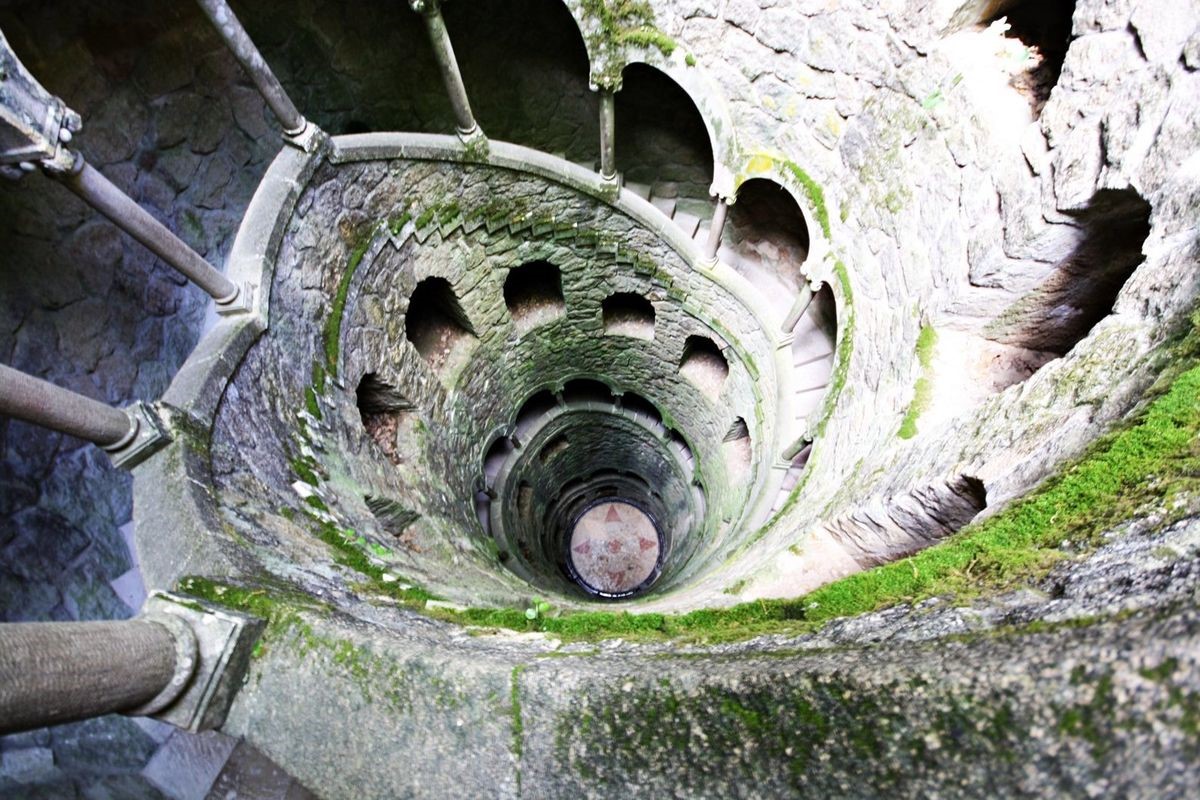
Quinta da Regaleira, Sintra, Portugal
The Renaissance Period (14th to 17th centuries) was the exponent of elegance and complexity for staircase architecture. This period meant a revival of ancient Greek and Roman culture, so artists and architects took symbolism one step further. Grand curved and spiral stone stairs were prominent. These stairs were known as “Staircases of Honour” and were designed to make the transition from the ground floor to the so called “piano mobile” (or upper floor) as pleasant and entertaining as possible. They were mostly influenced by theatre designers who conceived stairways to inspire a sense of power, achievement and enlightenment (Templer, p.128).
But mathematicians would also begin to take interest in the shape of stairs!
The “never-ending staircase effect”
In around the year 1200, mathematician Leonardo Fibonacci discovered the unique properties of the “Fibonacci sequence”, also known as Fibonacci’s Golden Ratio. The sequence of the numbers (0, 1, 1, 2, 3, 5, 8, 13, 21, 34), if visualized, makes a spiral. The Golden Ratio was used to achieve balance and beauty in many Renaissance paintings and sculptures, Leonardo Da Vinci being one of the artists who made use of it. Almost every spiral staircase forms this sequence, meaning that when looked at from a particular angle, they give the illusion of a never-ending staircase.
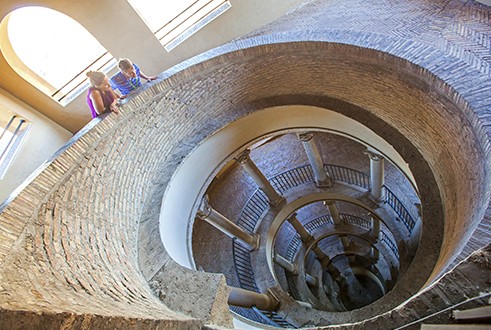
Bramante Staircase, Vatican (1505)
Staircases: a widely used metaphor in fiction
We all know the basic purpose of a staircase is merely utilitarian: it facilitates ascent and descent, i.e., it facilitates access to higher places. But remember we mentioned before that there’s more to a staircase than meets the eye? Literature, cinema and painting are often a source of imagery related to stairs and use staircases in various artistic narratives due to their extraordinary symbolic power. Some of the most famous film scenes set significant cinematic moments on or around staircases to enhance the meaning of a scene and therefore inspire grandeur, surprise, elegance and beauty!
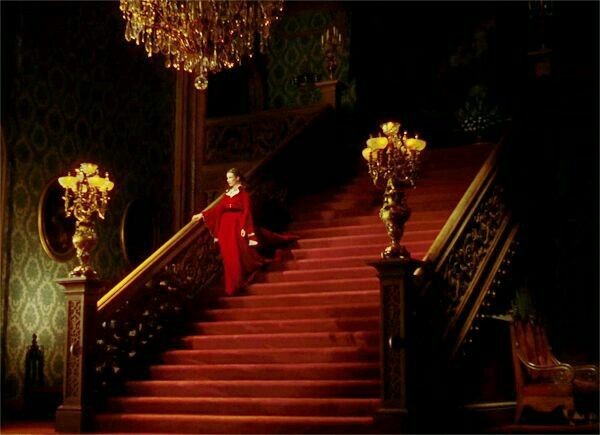
Vivian Leigh as Scarlett O’Hara on the red-carpeted staircase in “Gone with the Wind” (1943)
But thanks to the duality of stairs, they can also inspire fear and horror, and that is why they have often set the scene for murders! The beauty of staircases is that they can do either – inspire aesthetic delight or hypnotic horror!
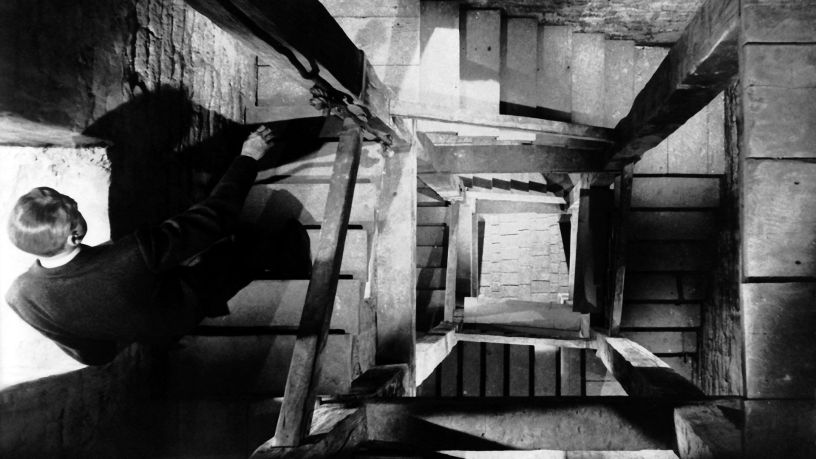
Alfred Hitchcock’s 1958 classic “Vertigo”: the main character suffers from acrophobia, an irrational fear of heights
Escher’s and Penrose’s impossible stairways
We have already mentioned stairs in nature, and stairs as symbols and metaphors brought into fiction, but what about impossible stairs that cannot exist as real objects?

“Relativity”, by M.C Escher (1953) and the Penrose Steps (1958)
Nature has inspired architects around the world to create astonishing structures, but there are also structures that cannot fit into the laws of nature. Therefore, mathematicians have found places for impossible structures to exist: in paintings or in dream-like worlds. One example of that is a lithographic print by M.C. Escher done in 1953. It´s called “Relativity” because each staircase angle depends on the subject’s position in space. Together, the different angles compose an impossible staircase.
Shortly after, and inspired by “Relativity”, a duo of mathematicians, Lionel and Roger Penrose, introduced the “impossible object”, also known as “The Penrose steps”, in a 1958 paper. In 1960, and in response to them, Escher reproduced the Penrose staircase “Ascending and Descending”:
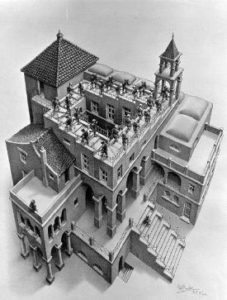
“Ascending and Descending”, by M.C Escher (1960)
The Penrose staircase in this print shows repetitive, endless work, with absolutely no practical purpose or result. In a letter to a friend, Escher explained his existentialist point of view:
“That staircase is a rather sad, pessimistic subject, as well as being very profound and absurd. (…) Yes, yes, we climb up and up, we imagine we are ascending; every step is about 10 inches high, terribly tiring – and where does it all get us? Nowhere.”
Motion pictures are the ultimate place for impossible stairs, as it is through this medium that Penrose staircases acquired movement and, somehow, came to exist in 3D. A famous movie that pictures Penrose staircases is Christopher Nolan’s “Inception”, in which complex spaces in the dreamlike world are designed by a character called Ariadne (named after the character from Greek mythology associated with mazes and labyrinths). To create the visual effects of Penrose steps, the stairs had to be built in such a way that when you view them from the highest level of the staircase, they should line up with the lowest level of the staircase. Only with a special camera lens could this be achieved!
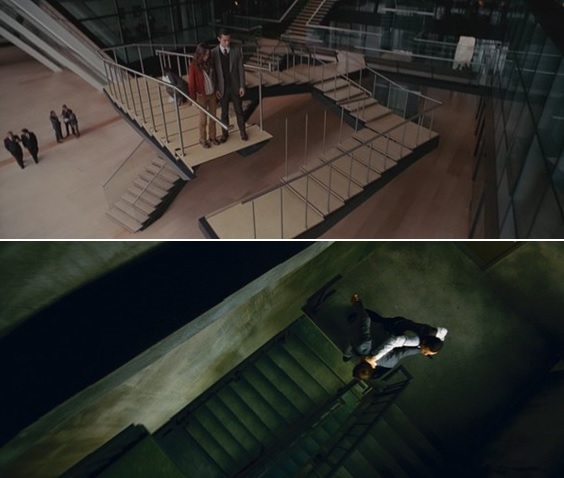
Christopher Nolan’s film Inception features a classic optical illusion called the Penrose staircase
Another example of Penrose steps in a motion picture is the moving staircases in Harry Potter. The staircases can literally swing ninety degrees from one position to the next. There had to be advanced levels of coordination between several teams in order achieve these visual effects and create the magic, while real-life actors stood on a single staircase that moved hydraulically in front of a green screen.
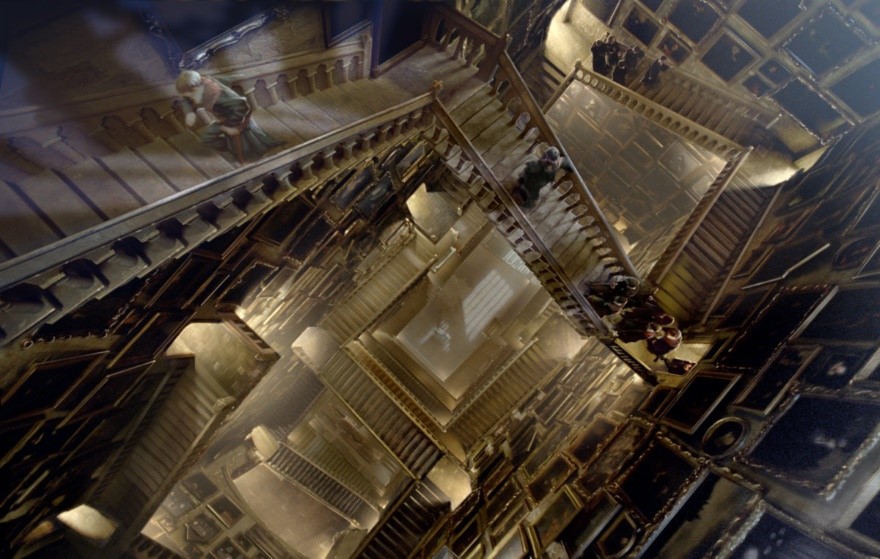
The moving stairs, in Harry Potter and the Prisoner of Azkaban: “I whip my stairs back and forth” says Harry Potter
Stairs in motion pictures are the only opportunity artists have to make stairs that would be impossible to achieve in real life come alive. Not being bound by the laws of nature is an extravagance that only film, and special effects can provide. As for real-world staircases, they will always be bound by the limits of the human body!
Staircases: The history of slips, trips and falls…
The architectural planning behind a staircase combines form and function, upper and lower space. However, stairs are always bound by the limits of the human body – which might be why they haven’t evolved much in the last few thousand years. Not to mention the fact that stairs can make us trip and fall more often than you would imagine!

In his comprehensive analysis of stairs, John Templer – Professor of Architecture at the Georgia Institute of Technology – also references research carried out over twenty years about slips, trips and falls on stairs. In fact, the epidemic of stair-related deaths and injuries cannot be overlooked, and his influential books have contributed to raising awareness of the issue, which is especially visible in an increasingly ageing society.
At Stannah, we have been well aware of the epidemic of stair-related falls and injuries since we built our first stairlift, more than 40 years ago. Although modern-day stairs usually have less complicated designs, the invention of stairlifts and lifts has changed how stairs are seen. To a certain extent, for many older adults struggling with stairs, getting the opportunity to glide up and down their stairs on a stairlift is a very welcome alternative to risking their safety on their stairs. This awareness has become increasingly important as the population of the world ages. Now, with our increased life-spans and as we start living in more inclusive societies, with a greater need for walkers and wheelchairs, stairs have become a real issue. So, should we consider the stairs villains now? They surely pose a real obstacle to universal access – a huge challenge that must now be tackled by modern architects. For example, how would they create a staircase that is accessible to all? Ramps are the obvious solution and can be very useful – but can also be very slippery. Around the world, while new solutions like innovative stairlifts and other lifting technology are appearing, to help people access conventional stairs, architects around the world are also rethinking stair design to try to make them usable to the elderly and people with disabilities.
What’s the future for stairs in modern architecture?
Until the nineteenth century, stairs were the only form of transportation to higher levels, and even now, stairs are necessary in all buildings to provide a safe exit route in an emergency. Looking into the future, it’s now clear that modern architects have started to focus on accessibility while designing stairs, so we think it’s safe to say that staircases will continue to be a vital part of buildings – even in the very distant future.
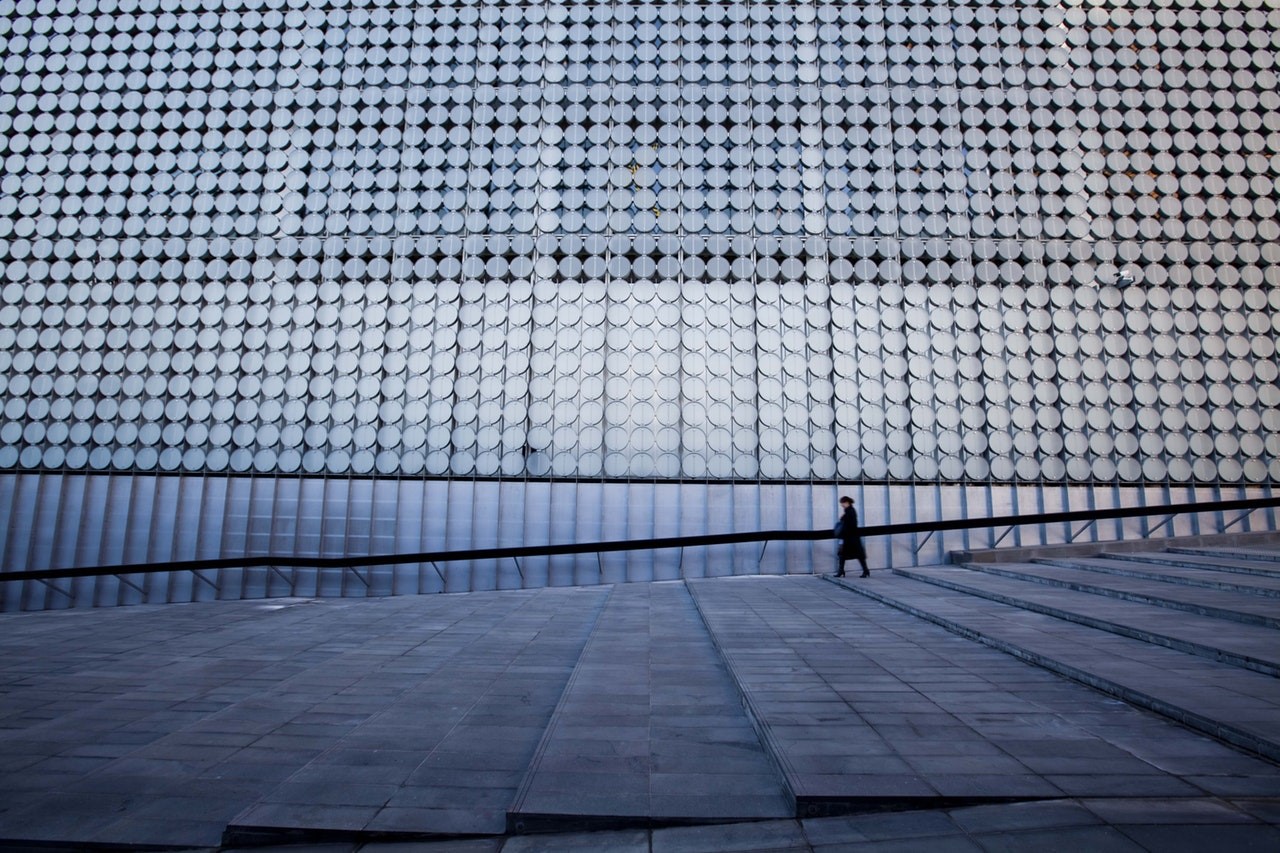
But there’s a sense of urgency around the evolution of stairs and a revolution in accessibility. And this is what the future holds for stairs: make them less visible, disguised in less sumptuous shapes so we feel as if we are gliding through them, and not climbing them. Hybrid versions of stairs and ramps just like the one in the image below are beginning to appear more often and will start to become the norm.
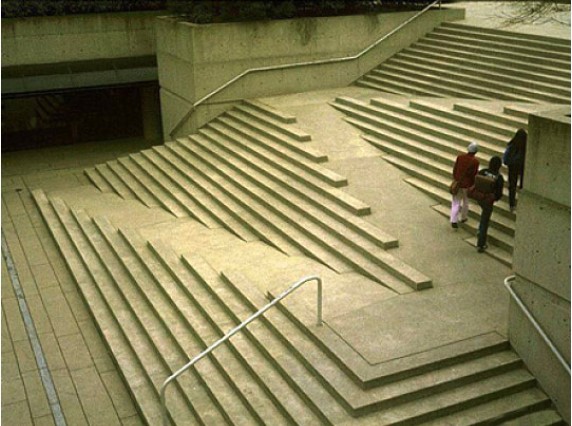
Robson Square in Vancouver: stairs that incorporate a wheelchair ramp
We hope we’ve been able to change how you see the staircases that surround you. The design of even the simplest staircase is complex, and requires great knowledge, skill and ingenuity. We’ve realized that stairs can be structures of aesthetic admiration and a source of universal inspiration, but they must also be structures that are designed more carefully, in order to provide safety and universal access. The future demands a different use for stairs, and architects are expected to take functionality and universal accessibility to the next level! And we should all be taking steps now to ease the climb!
Sources
- Templer, John. 1992. “The Staircase: History and Theories”. Cambridge, Massachusetts: The MIT Press.
- Wilkes, Joseph A. 1990. “Encyclopaedia of architecture: design, engineering & construction”
- Blanca, Oscar Tusquets & Diot, Martine. 2013. “The Staircase: The Architecture of Ascent”
- The impossible world of MC Escher, The Guardian
- Penrose Stairs, The Illusion Index
- Stairs can pose a problem as you get older, The Washington Post
- The Spiral Staircase – A pilgrim’s progress, The Independent
- The Evolution of the Staircase and Its Urgent Accessibility Revolution, Architecture Lab